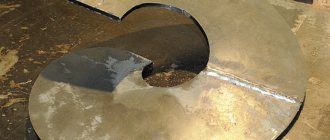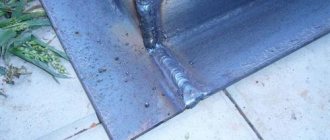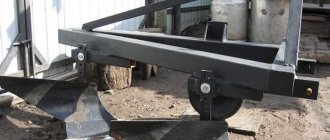Options for homemade hand cultivators
This important function can also be performed with a shovel . But hard work doesn't pay off. Labor efficiency itself increases several times if you use mechanized soil tillage. Any owner of a small plot of land can make a manual plow with his own hands. Special tools may require a welding machine.
It should be noted that soil cultivation began a very long time ago . Several decades ago, at the peak of the garden and dacha lifestyle, such a tool was very popular. It was either bought from factories or made independently.
The most popular types of tools are:
- Flat cutter. This is a tool similar to an ordinary hoe. He is a mechanized version of it.
- Rotary, or star. This plow works on the principle of alternately cutting the soil with knife-shaped stars.
- Cultivator "hedgehogs". It works on the principle of a rotary plow, but the ground is loosened not by knives, but by steel rods that look like a porcupine.
- Tornado. This tool looks like an ordinary pitchfork, but its rods are twisted in a spiral. Additional mechanical devices cannot be installed; it is only a hand tool.
The scope of application of the devices is the widest. Cultivators can perform the following tasks:
- loosen the soil, thereby saturating it with oxygen;
- cut rows for sowing crops and sprinkle them;
- rid plants from the influence of weeds, etc.;
- used together with a walk-behind tractor;
- break up lumps of soil and level the ground.
More about the device
The most popular are small designs whose weight does not exceed 20 kg. They are very productive and compact, and with the help of such products you can perform various tasks on the site: removing weeds, loosening the soil and even applying various fertilizers. A hand cultivator will also be useful when caring for some plants, as it is capable of loosening the soil near the beds, thinning and hilling them.
Note! Of course, you cannot compare a hand-held cultivator in terms of power with a walk-behind tractor, but for basic tasks in a garden plot it is quite enough. The advantages of hand tools include the absence of fuel or electricity costs, as well as the ability to use them in hard-to-reach places.
The design of most types of cultivators includes special cutters, which, moving around the site, loosen the soil. Other attachments can also be used:
- paws for loosening the soil;
- a special sock that loosens and cuts the soil, thereby removing weeds;
- hiller for creating small grooves in the soil, which are needed for sowing various crops;
- needle disk , which is used when a large crust forms on the soil surface;
- feeding knives with special dispensers . They are necessary for applying fertilizers to the soil.
When used correctly, hand cultivators make excavation work much easier. Of course, for this you need to use the appropriate nozzles and types of structures.
Required materials and tools
In order to always be able to make some necessary products at the dacha, it is necessary to prepare the most popular materials in advance.
First you need to stock up on a lot of steel. It should be in every workshop. The number of different strips, profiles and pipes determines how many necessary tools you can make with your own hands.
Welding will be an indispensable tool in every household. With its help, you can quickly and reliably connect all the parts of various structures. Bolts and nuts are used as an alternative to welding, but the reliability will not be comparable.
Many people do not know where to start when assembling a hand cultivator with their own hands. Drawings are the first thing a novice owner should stock up on . You also need to have the following set of tools and materials:
- Profile made of steel, pipe or fittings. This material will vary depending on the model chosen.
- Wheel and fastening to it. As an alternative, you should take a bicycle frame.
- Handle. For this part, you can use both metal pipes and shovel handles.
- Welding. You can connect parts using welding, or you can use bolts, but it is advisable to have welding.
- Drill with a set of drills.
- Grinder with cutting wheel.
What do you need for work?
To make various devices for soil treatment at home, you need to prepare special materials for this. First of all, you need to take care of getting steel. The more different pipes, sheets or metal rods you have, the better. You can’t do without a set of tools, but they are present in any garage, so you don’t have to bother finding them.
A welding machine is one of the most important tools for working with metal products. With it, you can connect different parts made of metal in just a few seconds. Of course, in most cases you can do without a welding machine by connecting the parts using self-tapping screws. But the quality of such connections cannot be compared with the quality of welds.
Cultivator "Tornado"
Making such a cultivator is not difficult. Its base can be made of a metal pipe. It is necessary to weld steel rods to the end of the lower part of the pipe, thereby forming a square shape. After this, the rods are bent in a spiral direction, and the ends are sharpened.
As an alternative, you can use a bicycle handlebar as a lever, and instead of a metal handle, install a shovel shaft. This will significantly save your own effort during work.
Such a device is designed for digging out various roots at great depths, for preparing holes for planting trees, etc. It can be used as an electrophoresis for cultivating the soil with your own hands.
Purpose
The Dokuchaevskaya PRSM-5 machine is a mounted universal tillage unit that is used in the cultivation of grain (winter and spring) and industrial crops to perform the following soil treatments: – pre-sowing; – main surface; – stubble peeling. It ensures the fulfillment of agricultural requirements in fields with loamy (light, medium and heavy loamy) soils with a slope of no more than 8o, soil moisture up to 25% and hardness up to 2.5 MPa. The tillage depth when working in fields intended for sowing and falling fallow can be adjusted from 0 to 15 cm. The machine is mounted with tractors of the 3rd traction class (T150K, HTZ-160, HTZ-170, MTZ-2112, etc. .).
How to make a flat cutter
Many people are looking for a cultivator for weeding. You can make such a weeding machine yourself. A profile pipe made of metal or steel is used as the basis for the frame. This base must be made of 2 parts. You need to weld at an angle of 30 degrees. A wheel fork made of a steel pipe or plate 3 millimeters thick is welded to the frame. The wheel itself can either be made independently or purchased. The steering wheel must be made of 2 steel pipes fixed to the frame.
The horizontal part of the frame is an adapter for the cutting attachment. Then you need to install a knife, which is made of steel tape 2-3 millimeters thick. Then the knives are sharpened. The sharpening angle can be changed or adjustable knives can be installed. If there is an old bicycle on the farm, then all the spare parts can be taken from it. Due to the large diameter of the bicycle wheel, the ride becomes very easy when working. The knife is made in the form of an inverted letter “P”, or T-shape. It should be noted that a T-shaped knife must be used very carefully between rows, as there is a possibility of spoiling the harvest.
A special subtype of the flat cutter is the design with forks. This device has several knives that are attached to a fork. It is made of steel rods, and they, in turn, are curved in a special way.
Recommendations for choosing a motor cultivator
When choosing a cultivator (manual, disk, automatic), it is recommended to consider:
Purpose. If the area of the plot does not exceed 25 acres, then you can choose a conventional manual or electric cultivator. For large areas and complex work, the optimal solution would be a walk-behind tractor; Appearance. When purchasing, carefully inspect the equipment for defects (scuffs, deformations, drips, chips, cracks). There should be no visible flaws; Brand. The cost of equipment depends on the manufacturer. High-quality equipment with reliable assembly has an appropriate price. By purchasing a branded product, the client has the opportunity to receive free service, and a guarantee is issued for the product; Serviceability. The equipment must be checked in the store for the functioning of its components and assemblies. The engine should start and run easily, the shafts should rotate. The throttle and clutch cables should move easily. Creases and abrasions are not allowed; Build quality
During an external inspection, pay attention to the fastening of bolts and nuts. There should be no loose or loose parts
When you turn on the device, all components should work and move without creaking or jerking; Documentation. A high-quality product must undergo certification; it must have a technological passport and instructions; Individual characteristics. If a cultivator is purchased for personal use, then you need to evaluate your own physical capabilities. Women and teenagers will not be able to work with heavy equipment.
Hand plow
Although such a device is called a plow, its intended purpose is contradicted. It does not have the classic properties of a plow. Even two people are not enough to work with such a tool. He is more of a classic cultivator. The device resembles a flat cutter, but an additional traction handle is installed.
Such a structure is handled by one person from the front, who acts as a traction force. And the second, the operator, controls the process of cultivating the land. It is impossible to use such a device without a co-pilot.
It is important to note that such a tool is not suitable for plowing soil for two reasons. The first is that a normal plow turns over layers of soil, but the device only loosens it. In addition, human power alone is not enough for normal plowing of the land.
Constructions
In addition to the option shown above (called “Tornado”, “Digger” or “Plowman”), there are several more variants of miracle shovel designs under different names.
Assembly drawing of a miracle shovel
Soil ripper without front support
This design also has working and support forks, but does not have a front stop. Because it is less bulky and weighs a little less. But the front stop gives increased stability during operation. And the weight when dragging is not so important.
The handle is attached to the working forks, the back stop is welded to the comb of the second forks. Both of these structures are movably connected to each other (even door hinges can be used).
Ripper miracle shovel for easy tillage
The photo shows one of the implementations, which is made on the basis of a corner and a round pipe. When working, the pins are driven into the ground by pressing on the crossbar, and not on the stop, as in most models.
Digger
An option called “Digger” is essentially a wide fork with a stop for easier turning and a high, powerful handle.
Miracle shovel "Digger"
The peculiarity of this design is the stop and the adjustable handle. It is fixed with two bolts and adjusted to the height of the working person.
The emphasis is not stationary, but movable. It is fixed to the frame. When plunging the pins into the ground, press on it with your foot, then, without removing your foot, turn it out by pressing the handle of the fork out of the ground.
Digger in action
The physical load during work is low, the work progresses quickly. But this miracle shovel will not work for hard and lumpy soils: it does not crush the soil. She collapses through the pitchfork under her own weight. But this is only possible on loose soils. On clay or black soil it is better to have a second comb with pins.
How to make a miracle digger, see the following video.
Lightcop
This miracle shovel design is slightly different from the previous one. The stops in it are rounded, the handle is arched, but the basic structure is the same. There is some drawback - there is no way to adjust the handle, but otherwise everything is the same - a movable stop and working forks.
Two options called "Lightcop". The simplest ripper for the vegetable garden, garden and cottage
It’s hard to say whether this variation is better or worse. It would be possible to evaluate only by comparing the performance of both copies on the same site.
If you watch the following video, you will see that with such a miracle shovel you can dig not only loose soils, but also heavy ones. And the second thing you can pay attention to is that for such soil it is better to have a second comb of pins, against which you can crush the inverted lumps.
Rotary or star
Making such a device is not a difficult task. To make the structure, you need 5-7 stars, which will serve as knives, strung onto the axle. These knives can be either straight or curved to the sides. After cultivating the soil with such a tool, it is recommended to walk between the rows and a flat cutter. A combination of two models is also possible, when the stars are first used in the design, and then a flat cutter is used for the final stage. This can significantly save the worker’s strength and energy. Since the stars perform the function of wheels in the design, an additional axle is not needed.
Working with such a tool is quite difficult, so only a physically trained person can handle it. In such a garden structure, you can install wheels of the same diameter instead of stars. In this case, you will get a good weeding hiller.
Restrictions
1. The use of the machine is effective on fields with loamy soils, i.e. with soils that initially have structure. Due to its crumbling, loosening, delamination, and separation, an optimal design of the treated layer is created. On structureless soils (sandstones, solonetzes, etc.), performing these operations will not lead to an increase in yield. 2. The quality of the machine depends on the physical condition of the soil
Its use on waterlogged and dried soils will not lead to optimization of the treated layer in terms of its structure and density
ATTENTION! The presented machine should not be confused with horizontal milling tillage units. She has only external, but not functional, similarities with them.
A deeper acquaintance with the machine allows you to verify this. The presented machine processes the soil layer cut by plowshares, exerting minimal mechanical impact on it. Horizontal milling machines process the soil only with a milling cutter, exerting a great dynamic effect on it.
Cultivator "Hedgehogs"
For the base you need to prepare a powerful fork made of steel strip. In front of the tool there is a working axis with attachments. They need to be made from pieces of pipe onto which steel rods with pointed tips are welded. Actually, that's where the name comes from.
Loosening is carried out by lightly shaking the soil and piercing it, but the weeds remain in place, especially their roots. The main advantage of this subtype is the easy movement of the tool. Inter-row passage is carried out almost effortlessly.
Kinds
Root remover
A manual root cultivator for the garden will help you fight weeds and dig small holes for seedlings. Operating principle: due to sharpened spiral teeth, by turning the gate, the device is “screwed” into the ground. The small area of contact with the ground allows this to be done with minimal effort.
Root remover
To do this, it is enough to make no more than half a turn around the axis. After deepening, using the handle and axle as a lever, the earth along with the roots of the weeds is removed out. It is very easy to operate and the performance is high.
The manual cultivator for the tornado garden has a very successful (and at the same time simple) design. The height of the collar is easily adjustable, which will allow a person of any height to work comfortably and not create a large load on the back. Showed excellent results when cultivating soil of varying degrees of hardness.
Choose models that come complete with various working attachments. In the future, the necessary ones can be purchased separately.
Petrol
A manual cultivator for a garden, a gasoline one (or a motorized cultivator) will be the most universal solution. The scope of its application is expanded by various replaceable attachments and attachments.
There is a huge selection of models on sale - from light (10-50 kg) to heavy walk-behind tractors (up to 500 kg), the performance of which is already close to a mini tractor.
Petrol
When choosing, do not be tempted by cheap models from unknown manufacturers - in the future there may be problems with maintenance and purchasing spare parts. Take a closer look at time-tested brands, for example: Tarpan, Patriot, Champion, Texas, Viking, Cayman.
For hand-held cultivators for a summer residence, the price can vary from 10 to 40 thousand rubles (gasoline cultivators) and reach up to 150 thousand rubles for walk-behind tractors.
Electric
An electric hand cultivator for a summer residence is lighter and easier to maintain than its gasoline counterpart. The main purpose is to loosen the soil. Advantages:
- light weight;
- ease of operation;
- low noise level;
- no exhaust gases;
Clearly visible in the photo:
Electric
When choosing, do not chase powerful models - anyway, he will not turn out to be a full-fledged “field worker”
Pay attention to lightweight, inexpensive models, for example Loplosh, Mantis, which a woman or an elderly person can easily handle
The disadvantages include being tied to a source of electricity. Not suitable for processing areas with unmown grass. Due to its relatively low power, it is capable of loosening only soft, sandy soil or cultivated black soil.
Star
A manual garden rotary cultivator (or star) is used to loosen soil and clods after plowing, mix soil with fertilizers and remove weeds. Operating principle: “arms” are attached to the working shaft at right angles, at the end of which there is a cutting edge.
There are several such elements along the entire length of the circumference, and in lateral projection they resemble an asterisk. Hence the name. With a gasoline or electric drive, the sprockets rotate quickly (regardless of the speed) loosening the soil.
Evezdochny
The manual cultivator for the garden is a star type without a mechanical drive, and has a pair of small support wheels. Also included is a knife, which (if turned towards the ground) cuts off grass and weed roots as it moves.
Immediately after purchase, it is better to replace the handle with a longer one - it will be much easier to work.











